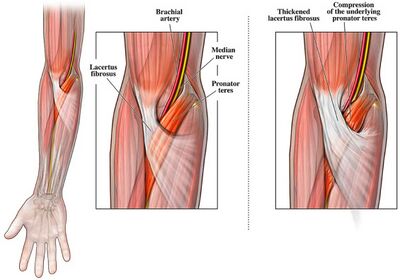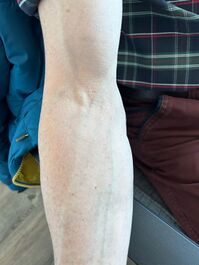Lacertus Syndrome: Difference between revisions
| Line 19: | Line 19: | ||
# Weakness: muscle weakness distal to nerve compression - flexor carpi radialis (FCR), flexor policis longus (FPL), and 2nd ray flexor digitorum profundus (FDP-II). | # Weakness: muscle weakness distal to nerve compression - flexor carpi radialis (FCR), flexor policis longus (FPL), and 2nd ray flexor digitorum profundus (FDP-II). | ||
# Tenderness and/or positive Tinel's at the level of nerve compression. The examiner places their thumb over the medial epicondyle, the middle finger over the biceps tendon, and palpates the lacertus fibrosus with the index finger. | # Tenderness and/or positive Tinel's at the level of nerve compression. The examiner places their thumb over the medial epicondyle, the middle finger over the biceps tendon, and palpates the lacertus fibrosus with the index finger. | ||
# Positive scratch collapse test (See https://www.youtube.com/watch?v=OD7y-mrj7YQ) | # Positive scratch collapse test (See https://www.youtube.com/watch?v=OD7y-mrj7YQ and https://www.youtube.com/watch?v=eFTj9BlMOpA) | ||
The Lacertus Antagonis Test is positive if FPL and FDP-II strength is restored when the elbow is compressed medially by the examiners hands or tape.<ref name=":2">Apard T, Martinel V, Batby G, Draznieks G, Descamps J. Lacertus syndrome: recent advances. Hand Surg Rehabil. 2024 Jun 7:101738. doi: 10.1016/j.hansur.2024.101738. Epub ahead of print. PMID: 38852811.</ref> | The Lacertus Antagonis Test is positive if FPL and FDP-II strength is restored when the elbow is compressed medially by the examiners hands or tape.<ref name=":2">Apard T, Martinel V, Batby G, Draznieks G, Descamps J. Lacertus syndrome: recent advances. Hand Surg Rehabil. 2024 Jun 7:101738. doi: 10.1016/j.hansur.2024.101738. Epub ahead of print. PMID: 38852811.</ref> | ||
Revision as of 20:02, 7 September 2024
Lacertus syndrome (LS) is caused by compression of the median nerve at the lacertus fibrosus, often seen in athletes engaged in overhead throwing activities. It is frequently misdiagnosed as Carpal Tunnel Syndrome (CTS), with many patients having had unsuccessful carpal tunnel release. However LS may coexist with LS as a double crush phenomenon.[1]
Anatomy and Pathophysiology

The condition is caused by compression of the median nerve at the lacertus fibrosus, a fibrous band distal to the elbow joint.
The median nerve runs along the medial side of the brachial artery, situated between the biceps brachii and the brachialis muscle. It courses under the ligament of Struthers and often gives a branch to the pronator teres just distal to the elbow. The nerve remains medial to the biceps tendon and brachial artery throughout its course and is located deep to both the lacertus fibrosis (bicipital aponeurosis) and the pronator teres muscle. The lacertus fibrosis is not the primary fascia of the superficial volar compartment but acts as a constricting band around the pronator teres.
Risk Factors
The most commonly affected sports-people are baseball pitchers, American football quarterbacks, golf, tennis, or weightlifting. Occupational risk factors are dentistry and surgery.
Clinical Features

Patients with lacertus syndrome typically present with a loss of hand strength (95.6%) and endurance (i.e. fatigue - 73.3%), forearm pain (35.4%), and occasional median nerve distribution numbness.[1]
The syndrome has a diagnostic clinical triad (Hagert) that consists of weakness in the muscles innervated distally to the lacertus fibrosus, pain over the compression point at the lacertus, and positive scratch collapse test.
- Weakness: muscle weakness distal to nerve compression - flexor carpi radialis (FCR), flexor policis longus (FPL), and 2nd ray flexor digitorum profundus (FDP-II).
- Tenderness and/or positive Tinel's at the level of nerve compression. The examiner places their thumb over the medial epicondyle, the middle finger over the biceps tendon, and palpates the lacertus fibrosus with the index finger.
- Positive scratch collapse test (See https://www.youtube.com/watch?v=OD7y-mrj7YQ and https://www.youtube.com/watch?v=eFTj9BlMOpA)
The Lacertus Antagonis Test is positive if FPL and FDP-II strength is restored when the elbow is compressed medially by the examiners hands or tape.[3]
The Lacertus notch can be a helpful clinical sign with a sensitivity of 65.1% and specificity of 68.97% (Note these values were not specifically reported in the abstract, they were calculated manually from the figures provided in the study.)[4]
Investigations
Electrophysiology studies are frequently negative. This is because the compression is typically mild or dynamic in nature, and hence there is insufficient axonal injury for detection.
Invasive pressure measurements, similar to those used for CECS in the legs, have been employed in the past, but they carry risks of injury to surrounding structures.
Pre- and post-exercise MRI has provided a less invasive and reliable diagnostic method.[2]
Differential Diagnosis
Multiple distinct conditions can cause compression of the median nerve - Carpal Tunnel Syndrome, Lacertus Syndrome, Superficialis-Pronator Syndrome, and Struther's ligament syndrome. Struther's ligament syndrome is very rare.
| Feature | Carpal Tunnel Syndrome | Lacertus Syndrome | Superficialis Pronator Syndrome |
|---|---|---|---|
| Symptoms | Numbness, tingling in fingers | Forearm pain at elbow | Diffuse forearm pain |
| Sensory | Palmar side of fingers | Possible median nerve distribution | Generalized, less pronounced |
| Motor | Weakness in APB muscles | FPL, FDP2, FRC muscle weakness | FPL, FDP2-3, FRC muscle weakness |
| Night Symptoms | Common, worsen at night | Less common at night | Rare |
| Activities | Difficulty gripping, manual tasks | Fatigue with elbow flexion, forearm activities, difficulty in pinch | Discomfort with forearm movements |
| Provocative Tests | Positive Tinel's at wrist, Phalen's test | Elbow flexion, pain on LF | Provoked by pronation, repetitive movements, no pain on LF |
| Position | N/A | Worsens with wrist flexion, worsens in elbow pronation | Triggered by specific forearm activities |
| Onset | Gradual, repetitive strain | Abrupt or gradual, activity level dependent | Gradually, activity specific |
| Pattern | Swelling sensation | Elbow tenderness | Diffuse forearm tenderness |
Treatment
Conservative management involves activity modification (reducing repetitive elbow flexion, forearm pronation, and foreceful gripping), taping, nerve gliding, and NSAIDs.[3]
Injections can have a diagnostic and therapeutic role.
Surgical release of the lacertus fibrosis has been shown to provide excellent outcomes for lacertus syndrome.
Miscellaneous
Lacertus syndrome was first described by George Bennett in 1959 as a condition affecting overhead throwing athletes. It was originally described as compression of the median nerve between the two heads of pronator teres, but later the role of the lacertus fibrosus was discovered.
Resources
Literature Review
- Reviews from the last 7 years: review articles, free review articles, systematic reviews, meta-analyses, NCBI Bookshelf
- Articles from all years: PubMed search, Google Scholar search.
- TRIP Database: clinical publications about evidence-based medicine.
- Other Wikis: Radiopaedia, Wikipedia Search, Wikipedia I Feel Lucky, Orthobullets,
References
- ↑ 1.0 1.1 Hagert E, Jedeskog U, Hagert CG, Marín Fermín T. Lacertus syndrome: a ten year analysis of two hundred and seventy five minimally invasive surgical decompressions of median nerve entrapment at the elbow. Int Orthop. 2023 Apr;47(4):1005-1011. doi: 10.1007/s00264-023-05709-w. Epub 2023 Feb 9. PMID: 36757413; PMCID: PMC10014674.
- ↑ 2.0 2.1 Mehl A, Stevenson J, Royal JT, Lourie GM. Lacertus syndrome: Use of pre- and post-exercise MRI to aid in diagnosis and treatment. Radiol Case Rep. 2021 Mar 4;16(5):1113-1117. doi: 10.1016/j.radcr.2021.02.022. PMID: 33732403; PMCID: PMC7937939.
- ↑ 3.0 3.1 3.2 Apard T, Martinel V, Batby G, Draznieks G, Descamps J. Lacertus syndrome: recent advances. Hand Surg Rehabil. 2024 Jun 7:101738. doi: 10.1016/j.hansur.2024.101738. Epub ahead of print. PMID: 38852811.
- ↑ Brutus JP, Vo TT, Chang MC. Lacertus notch as a sign of lacertus syndrome. Pain Pract. 2024 Mar 29. doi: 10.1111/papr.13372. Epub ahead of print. PMID: 38553626.


